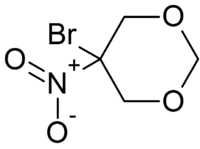Bronidox
| Structural formula | ||||||||||||||||
|---|---|---|---|---|---|---|---|---|---|---|---|---|---|---|---|---|

|
||||||||||||||||
| General | ||||||||||||||||
| Surname | Bronidox | |||||||||||||||
| Molecular formula | C 4 H 6 BrNO 4 | |||||||||||||||
| Brief description |
almost colorless crystals |
|||||||||||||||
| External identifiers / databases | ||||||||||||||||
|
||||||||||||||||
| properties | ||||||||||||||||
| Molar mass | 212.00 g mol −1 | |||||||||||||||
| Physical state |
firmly |
|||||||||||||||
| Melting point |
58-60 ° C |
|||||||||||||||
| boiling point |
Decomposition from 113–116 ° C (17 hPa ) |
|||||||||||||||
| solubility |
hardly soluble in water (4.6 g l −1 at 20 ° C) |
|||||||||||||||
| safety instructions | ||||||||||||||||
|
||||||||||||||||
| As far as possible and customary, SI units are used. Unless otherwise noted, the data given apply to standard conditions . | ||||||||||||||||
Bronidox ( 5-bromo-5-nitro-1,3-dioxane ) is a chemical compound from the group of 1,3-dioxanes that is bacteriostatic .
Bronidox is therefore suitable as a preservative for cosmetics and is one of the most frequently used active ingredients.
The compound is metabolized to bronopol , 2-nitropropanediol and 2-nitroethanol .
| Bronidox | formaldehyde | PHB ester | |
|---|---|---|---|
| Escherichia coli | 50 | 60 | 800 |
| Pseudomonas aeruginosa | 50 | 125 | 800 |
| Staphylococcus aureus | 75 | 60 | 500 |
| Kocuria varians | 25th | - | - |
| Candida albicans | 25th | 250 | 800 |
| Aspergillus niger | 10 | 250 | 250 |
Individual evidence
- ↑ a b c Entry on 5-bromo-5-nitro-1,3-dioxane. In: Römpp Online . Georg Thieme Verlag, accessed on November 7, 2015.
- ↑ a b c d M. Potokar, W. Greb, H. Ippen, HI Maibach, KH Schulz, P. Lorenz, Chr. Gloxhuber: Bronidox, a new preservative for cosmetics . Properties and toxicological-dermatological test results. In: fats, soaps, paints . tape 78 , no. 7 , 1976, p. 269-276 , doi : 10.1002 / lipi.19760780703 ( PDF ).
- ↑ a b Data sheet 5-Bromo-5-nitro-1,3-dioxane, ≥99% from Sigma-Aldrich , accessed on May 30, 2017 ( PDF ).


